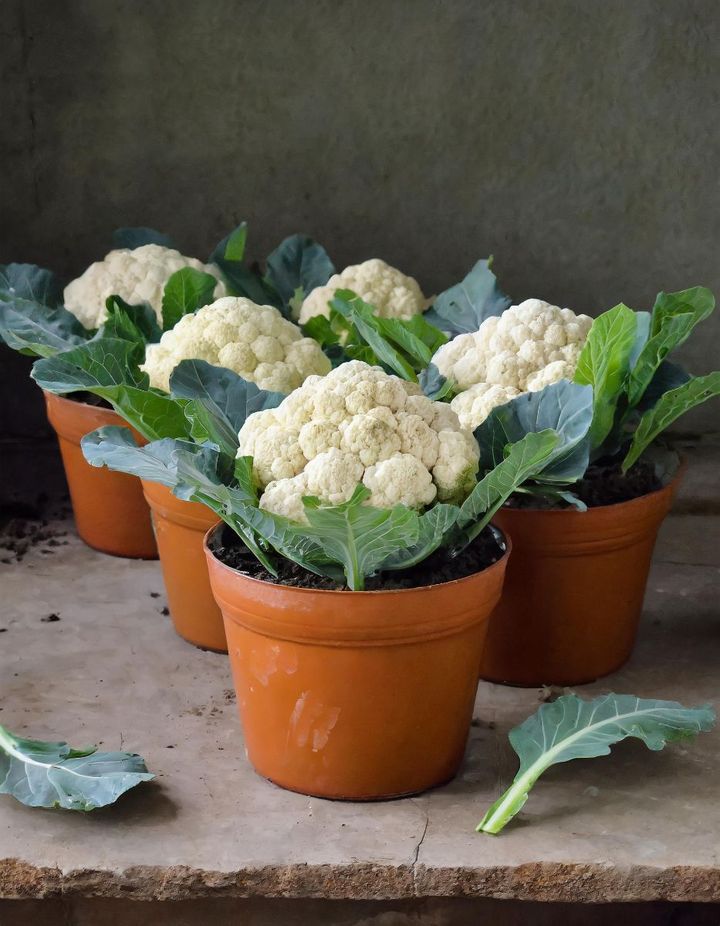|
Growing your own vegetables is an incredibly rewarding experience that promises fresh produce straight from your garden to your table. Cauliflower is an especially interesting challenge and can provide ample satisfaction when you finally cut off that large, creamy white head for your next meal. But what if you don’t have a garden? No problem! With this step-by-step guide, you’ll learn how to grow the biggest cauliflower using pots, perfect for patios, balconies, or any small space garden.
Step 1: Choose the Right Pot
Select a pot that is at least 12-18 inches deep and equally wide to accommodate the growth of a large cauliflower. Ensure the pot has several drainage holes to prevent waterlogging. Drainage is crucial because cauliflower roots are susceptible to rot if they’re too wet.
ADVERTISEMENT
Step 2: Select the Right Soil Mix
The best medium for growing cauliflower is a loose, fertile, well-draining soil mix. You can create your own mix by combining equal parts of garden soil, compost, and perlite or vermiculite. This will ensure your cauliflower gets the necessary nutrients and the pot has good drainage properties.
Step 3: Pick a High-Quality Cauliflower Variety
Choose a cauliflower variety known for producing large heads. Varieties such as ‘Snowball’, ‘Autumn Giant’, and ‘Amazing’ are suitable for container gardening and capable of producing sizeable cauliflower heads. Also, consider buying transplants from a reputable nursery, or if you’re starting from seeds, begin them indoors about four to six weeks before you plan to move them outdoors.
Step 4: Planting
1. Fill your selected pot with the soil mix, leaving about an inch from the rim.
2. Plant the cauliflower transplant in the pot, ensuring the base of the plant is level with the top of the soil. 3. Water your plant thoroughly after planting to settle the soil around the roots. Step 5: Provide Sufficient Sunlight and Water
Place your potted cauliflower in an area that receives at least 6 hours of sunlight per day. Regular watering will help the plant to produce a large, tight head. The soil should remain moist but not soggy. Use your finger to check the soil moisture; when the top inch feels dry, it’s time to water.
Step 6: Nutrient Supply
Feed your cauliflower plant with a balanced, water-soluble fertilizer every two weeks to promote growth. As the cauliflower head begins to form, you may need to provide more nitrogen to support its size. However, be cautious with fertilizer, as too much can lead to leafy growth at the expense of the cauliflower head.
Step 7: Blanching
Once the cauliflower head starts to form and you can see it’s about the size of an egg, it’s time to begin blanching. This involves tying the outer leaves over the developing head to protect it from direct sunlight and maintain the head’s white color. Keep the leaves secured with twine or elastic bands until harvest.
Step 8: Monitoring for Pests and Diseases
Regularly inspect your cauliflower for signs of pests like aphids, caterpillars, and slugs. Employ organic controls such as neem oil or insecticidal soap as needed. Diseases like mold and mildew can also be an issue, which can be controlled with proper air circulation around the plant and not overwatering.
Step 9: Harvesting
Harvest your cauliflower when the head is firm, white, and reaches the desired size—typically 6-8 inches in diameter but can grow larger depending on the variety. Cut the head off the stem with a few leaves left on to protect it, and enjoy it fresh from your container garden!
ADVERTISEMENT
Growing cauliflower in pots can be simplified with the right preparations and ongoing care. Your success will not only bring delicious results but also the pride of having nurtured a sizable centerpiece for your dinner table right from your small space garden. Happy gardening!
|
Grow the biggest cauliflower in a pot using this step-by-step guide



